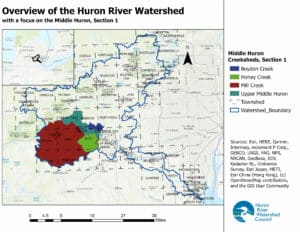
The Middle Huron River Watershed Management Plan (WMP): Section 1 is part of an effort led by communities in this area seeking to plan activities to address water quality issues highlighted in the State of Michigan’s Clean Water Act §303(d) report on impaired waters. The original WMP was completed in 1994, updated in 2000, 2008, and 2011, but was written for a larger area, covering the entire Middle Huron Watershed which covers the confluence of Mill Creek down to the end of Belleville Lake, and all tributaries draining to the Huron through that length. This 2022 version is the fourth update of that WMP, but it is narrower in scale as it only covers the upper geographic portion of that earlier WMP. Separate WMPs were written for the middle (Section 2) and lower (Section 3, not yet approved) geographic portions.
For the purposes of this plan, Section 2 of the Middle Huron Watershed is composed of direct drainage to the Huron River from Flook Dam on Portage Lake through the top of Barton Pond, as well as the Mill, Boyden, and Honey (Scio Township region) subwatersheds.
This plan was approved by EGLE and the US EPA in November 2022.
BODY- Full text of document except for Appendices.
APPENDICES
Appendix A. Total Maximum Daily Load for Total Phosphorus in Ford and Belleville Lakes
Appendix B. Honey Creek E. Coli Total Maximum Daily Load
Appendix C. Michigan’s Statewide E.Coli Total Maximum Daily Load
Appendix D. Middle Huron Partnership Cooperative Agreement
Appendix E. Honey Creek Watershed Management Plan
Appendix F. Threatened and Endangered Species in Washtenaw County, 2022
Appendix G. Summary of Geomorphology Assessment Results for the Middle Huron River Watershed, Section 1.
Appendix H. Post-Project Data Summary, Reducing Bacteria in Honey Creek
Appendix I. Huron Clinton Metropark Authority Stormwater Plans: Delhi, Dexter-Huron, Hudson Mills
Appendix J. Public Education Plan
Appendix K. Water quality accomplishments from plan partners from 2009-2021



